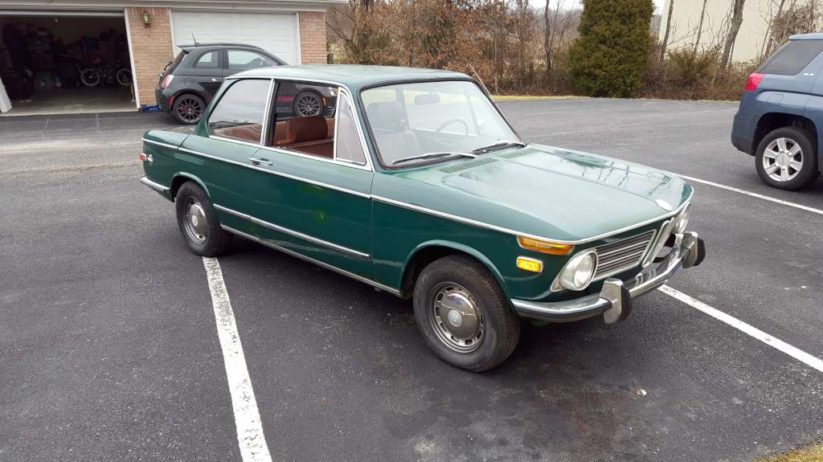
Rob Siegel
As soon as I survived The Flu From Hell and felt like I had the cognitive and motor skills necessary to navigate the OSHA-noncompliant disaster area that constitutes my garage, I set about clicking through the punch list needed to prepare Louie for the 900-mile trip to the BMW CCA Foundation in Greer, South Carolina, and his participation in the Foundation’s exhibit on “The Icon: 50 Years of the BMW 2002.” Fortunately, it’s mostly small stuff (e.g., no head gaskets and clutches, although note to self: Check head gasket and clutch).
Change oil and filter. For my entire adult life, I’ve used Castrol 20W50 in the vintage cars. It’s a combination of habit, brand loyalty, and laziness. However, several comments from friends about alarmingly high cold-oil pressures made me think that perhaps, since I’d be driving Louie 900 miles during winter, dialing it back to 10W40 might be prudent.
I drained the old oil and changed the filter, but when I began pouring in the 10W40, boy, that stuff looked thin in comparison to 20W50, even in my cold garage—certainly not as thin as the 0W20 I put in Maire Anne’s Honda Fit, but visibly less viscous than 20W50. I put the question up to the brain trust at bmw2002faq.com, and the consensus was that I’m doing the right thing and should quit worrying about it.
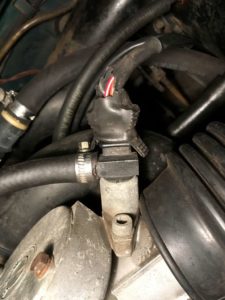
Install cold-start switch. Like other 1970s and 1980s-era injected BMWs, 2002tii’s have a cold-start mechanism that includes a cold-start valve—essentially a fifth injector—on the throttle body, controlled by a temperature sensor and a thermo time relay that tells the valve to squirt fuel for a period determined by the temperature reading. It’s very common for the thermo-time-relay boxes to fail. Usually they fail in the open position, and don’t turn the valve on at all; mine appears to have failed in the closed position, so for the year I’ve had Louie, when I’ve started it in cool or cold weather, I’ve plugged the electrical connector into the cold-start valve, cranked the car over, and as soon as it starts, simply unplugged the connector. When I re-start the car, I need to remember to plug the connector back in.

I thought that this sequence might be a bit awkward for someone at the Foundation to follow whenever the car needs to be moved, so I resolved to fix it. First I followed the troubleshooting procedure from our friends at Jaymic in Great Britain to be certain the problem was indeed in the thermo time relay (https://www.bmw2002.co.uk/wp-content/uploads/2012/01/Jaymic-Fuel-Injection-Bulletin-V2.pdf). It was. Then I did what I’ve done in many other tii’s: bypassed the relay. In the past, I’ve sometimes done this somewhat brutally by cutting the wires to the connector and splicing new wires to it, running one wire to ground and the other to a switch inside the car. Since Louie has such an original-looking engine compartment, and since I’ve gotten some degree of religion over such things in recent years, this time I did it in a far less invasive manner. (First, I guess I should say that a new thermo time relay lists for nearly $300, so this new religion only goes so far.)
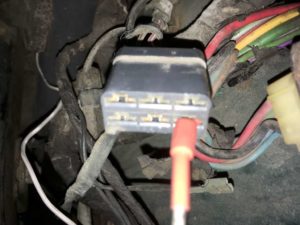 I undid the connector going into the bottom of the thermo time relay, and using a multimeter, found the terminal on that connector that goes to the positive wire on the cold-start valve. I then ran a new wire through the firewall, snaking it through the boot around the speedometer cable, crimped a male spade terminal onto the wire, and inserted the spade into the correct female terminal in the connector. A second ground wire isn’t necessary, because the cold-start valve is already grounded through the existing wiring.
I undid the connector going into the bottom of the thermo time relay, and using a multimeter, found the terminal on that connector that goes to the positive wire on the cold-start valve. I then ran a new wire through the firewall, snaking it through the boot around the speedometer cable, crimped a male spade terminal onto the wire, and inserted the spade into the correct female terminal in the connector. A second ground wire isn’t necessary, because the cold-start valve is already grounded through the existing wiring.
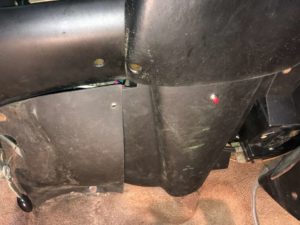
I heat-shrank a piece of tubing around the whole connector to keep water off it, and zip-tied it up under the firewall’s overhang. I then installed a small momentary-on pushbutton switch on the under-column panel above my knees. This did require drilling a small hole in the trim panel, something that gave me pause—the more time elapses, the more you need to make a lawyer’s case for drilling a hole anywhere in a 2002, even if it’s only in a pressed fiberboard panel—but it’s not a rare piece, and I have others.
As a byproduct of the switch installation, I installed the other under-column trim panels, which had not been on the car since I’d hurriedly pulled them off when the low-beam/high-beam stalk disintegrated on the Merritt Parkway on the way to the Vintage last spring.
Swap radiators. Speaking of last year’s preparations for the Vintage, last spring I pulled Louie’s original radiator, which appeared to be contributing to less-than-stellar cooling-system performance, and replaced it with an inexpensive Spectra CU739 320i radiator. I wrote about the process of mounting it without drilling any holes in the nose here (https://www.bmwcca.org/roundel/cruelty-free-2002-radiator-installation).
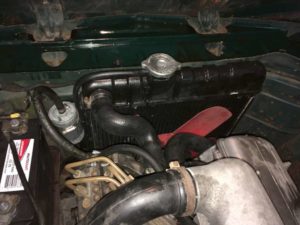
But my new religion was affecting me in odd ways, and with the car going on display, I really didn’t like theway the Spectra looked in the otherwise original-looking engine compartment. Factory 2002 radiators are pricy, with the discounted list price over five hundred bucks; the knock-offs that Walloth und Nesch sells are less expensive, but I didn’t know if I could get one in time.
Then it hit me: I had a recent and correct radiator in Kugel, my other ’72 tii. The car is in winter storage out in Fitchburg, but it was easy enough to pull the Spectra out of Louie, drive out to Fitchburg, and swap radiators with Kugel, which is a less-original tii than Louie anyway.
Correct some underhood fasteners and hose clamps.
The new religion continues. I never used to 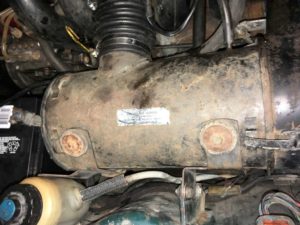 give a horse’s patootie whether a 10-mm bolt was original to the car or came from Ace Hardware, but again, with Louie’s remarkably undisturbed engine compartment, some of the bright, shiny fasteners I’d installed in haste—such as the ones attaching the air-filter housing to its bracket—stuck out like a pre-prom nose pimple. Five minutes spent picking through the 35-year accumulation of fasteners in my bolt bucket unearthed several with the appropriate patina. I also found the big (and correct) hose clamps that secure the intake boot between the air cleaner and the throttle body; I’d left these off the car for a year, since I was always yanking the air-cleaner housing in and out. The rubber boot seals pretty well without them, and even if there’s a leak, it’s not a vacuum leak—it’s just a small leak of unfiltered air.
give a horse’s patootie whether a 10-mm bolt was original to the car or came from Ace Hardware, but again, with Louie’s remarkably undisturbed engine compartment, some of the bright, shiny fasteners I’d installed in haste—such as the ones attaching the air-filter housing to its bracket—stuck out like a pre-prom nose pimple. Five minutes spent picking through the 35-year accumulation of fasteners in my bolt bucket unearthed several with the appropriate patina. I also found the big (and correct) hose clamps that secure the intake boot between the air cleaner and the throttle body; I’d left these off the car for a year, since I was always yanking the air-cleaner housing in and out. The rubber boot seals pretty well without them, and even if there’s a leak, it’s not a vacuum leak—it’s just a small leak of unfiltered air.
Replace bad headlight. Somewhere on the way home from the Vintage last year, Louie’s right low beam went bad. Replacing it was more of a pain than I expected; first, I’d forgotten that these old deep-bucket front grilles are held on in the corner with a hooked fastener that you need to undo from behind the headlight. The three little screws holding the trim ring around the headlight probably hadn’t been removed since Nelson Rockefeller was vice-president. Some soaking in Silikroil and careful alignment of a fresh screwdriver with a good sharp tip in the slots got the little screws off. I even found in my parts closet a GE sealed-beam halogen bulb to match the one that remained on the left side.
Install working horn. Since Louie will be at the Foundation museum for almost eleven months, and since the car’s Massachusetts state inspection sticker runs out in March, it behooves me to get the car inspected before I deliver it. When I checked things, though, I found that the horn didn’t work. Usually, on a 2002, the culprit is the little plunger behind the steering wheel, but in Louie’s case, both of the horns were simply missing. I have a vague recollection of pulling them out of Louie to get Old Blue inspected last year; I’d completely forgotten about it. Again, as with the headlight, my parts closet came to the rescue: I found a box in which I had six horns.

I tested them one by one, wiring them directly to a battery. Of the six, only one worked, but one is enough for inspection.
And then I did something I rarely do: Having triaged the pile into one good horn and five bad ones, I threw the five bad ones straight into the garbage can.
Well, after I undid and saved the mounting hardware first. You never know.—Rob Siegel
Got a question for Rob Siegel, the Hack Mechanic? You can find him in the BMW CCA Forums here!
Rob’s new book, Ran When Parked: How I Resurrected a Decade-Dead 1972 BMW 2002tii and Road-Tripped it a Thousand Miles Back Home, and How You Can, Too, is now available on Amazon. Or you can order personally inscribed copies through Rob’s website: www.robsiegel.com.

